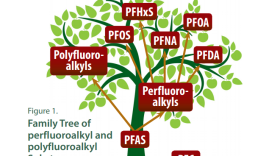An environmental group believes the class of toxic chemicals at the center of contamination crises in communities like Hoosick Falls and Newburgh can likely be detected in all major water supplies in the United States.
The Environmental Working Group released a report Wednesday that showed detectable levels of PFAS chemicals in major U.S. cities – Miami, Philadelphia, New Orleans, and suburban New Jersey. Of tap water samples taken from 44 places in 31 states and the District of Columbia, only one had no detectable contamination.
A conference call hosted by the EWG Wednesday included Democratic New York Congressman Antonio Delgado, Hoosick Falls Mayor Rob Allen, and actor Mark Ruffalo, who recently produced and starred in “Dark Waters,” about the real-life PFAS groundwater contamination crisis in Parkersburg, West Virginia.
“We know that PFAS chemicals had been linked through animal, worker, and human studies to serious health problems. And thanks to this report being released today by EWG, we know that PFAS has contaminated the drinking water of many, many more people than had been previously estimated,” said Ruffalo.
The report comes soon after the passage of the PFAS Action Act, which includes 11 bills focused on preventing PFAS pollution.
One of the bill’s sponsors, Rep. Delgado of 19th District, represents the Rensselaer County communities of Hoosick Falls and Petersburgh – both dealing with contaminated drinking water supplies.
“The PFAS Action Act includes several important measures that will increase our understanding of these chemicals and keep our communities safe. Most notably, the bill requires the EPA to set a maximum contaminant level of PFOA and PFOS within two years of the enactment. A number of states have already, reasonably so, set an MCL and right now we do not have one at the federal level,” said Delgado.
The U.S. Environmental Protection Agency has a drinking water health advisory level of 70 parts per trillion for PFOA and PFOS. But the federal government does not have a maximum contaminant level. And EWG says its sampling discovered six or seven PFAS chemicals per sample on average.
EWG President Ken Cook predicted the emerging science on the health effects of PFAS chemicals will continue to drive the so-called “safe levels” of the compounds in drinking water lower and lower.
“The more we learn, the lower these safety limits tend to go. And this is true across a wide range of toxic chemicals – it’s certainly true of PFAS. Secondly, because we found some types of PFAS that have not been found in drinking water before, we know that this contamination problem is not only affecting more people but has a wider range of contaminants that we need to be worried about,” said Cook.
PFOA was discovered in Hoosick Falls water supplies in 2014. Mayor Rob Allen predicted many more communities across the country will have to go through a similar crisis he called avoidable.
“I’d rather be here talking about the great rural setting of our village and how it’s a great place to raise a family but the fact is, our name is now synonymous with PFAS water contamination, due in large part to a lack of regulations that empowered industry to not care about PFOA releases and discharges into the environment,” said Allen.
The search is on for a new water supply for Hoosick Falls, and residents have been living with filtered water since 2016. Allen credits New York state declaring PFOA and PFOS hazardous substances in January 2016 as the most important step in changing the course of the village, and holding polluters accountable.
“We are now fully cognizant of the dangers of PFAS contamination to our health and the health of our children – it’s something we will spend the rest of our lives keeping an eye on. But our story is so important to get out there because it is a cautionary tale of what could happen if regulations had been appropriately handled when EPA learned of this years ago, and because so many more communities are about to go through everything we have been through. And without proper regulations at a national level, these communities are going to be powerless to get results,” said Allen.
Report: PFAS Pollution Widespread

WAMC






